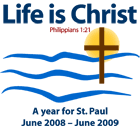Official Website of the
Catholic Diocese of Little Rock
Paul's Images Help Shape the Church
Published: March 14, 2009
This is the 10th column in a 13-part series
By Cackie Upchurch
Director of Little Rock Scripture Study
When Jesus began his ministry he proclaimed “the kingdom of God is at hand” (Mark 1:15). When Paul began his ministry he preached Jesus Christ, the embodiment of that kingdom. And he preached not to those he identified as disciples, but to those identified as brothers and sisters, the body of Christ, and the temple of God.
 Paul’s writings illuminate how the disciples and first generations of believers came to understand themselves in relation to Christ and to one another. Every generation since his time has continued to feel itself challenged and shaped by these images. In his correspondence with the Christians in Corinth Paul provides rich language for the Church’s self-understanding. One such image is the Church as a body. Using the body to describe the functions of an organization or society was quite ordinary in the secular speech of the day where the seemingly more significant members employed such language to keep the lesser members in their place.
Paul’s writings illuminate how the disciples and first generations of believers came to understand themselves in relation to Christ and to one another. Every generation since his time has continued to feel itself challenged and shaped by these images. In his correspondence with the Christians in Corinth Paul provides rich language for the Church’s self-understanding. One such image is the Church as a body. Using the body to describe the functions of an organization or society was quite ordinary in the secular speech of the day where the seemingly more significant members employed such language to keep the lesser members in their place.
Paul takes that image in a new direction in 1 Corinthians 12. The body used in his analogy is now the body of Christ, and in Christ there is no distinction between Jews or Greeks, slaves or free, woman or man — no sense of the seemingly lesser members being insignificant.
In fact, Paul says “the parts of the body that seem to be weaker are all the more necessary, and those parts of the body that we consider less honorable we surround with greater honor ... so that there may be no division in the body, but that the parts may have the same concern for one another” (12:22-25).
Individual and diverse responsibilities within the Body of Christ are also highlighted in the fourth chapter of Ephesians. To the local church in Corinth Paul says simply “you are Christ’s body” (1 Corinthians 12:27), a lesson that will be echoed through the centuries. St. Theresa of Avila’s great prayer begins “Christ has no body now but yours, no hands, no feet on earth but yours.”
The Second Vatican Council revived the use of this Pauline image in its “Dogmatic Constitution on the Church” and its “Pastoral Constitution on the Church in the Modern World” where it speaks of the Church using this imagery and others, including the people of God. In his first letter to Corinth, Paul addressed the local church’s concern that some follow him while others follow Apollos. Paul assured them that whoever plants and waters means nothing since God causes the growth, and then he says “For we are God’s co-workers; you are God’s field, God’s building” (3:9).
Paul rarely uses agricultural images such as watering seeds or tilling a field. He is a city person, and a traveler who is seeing the wider world. His images are usually more urban. In fact, after he tries to settle their concerns, he drops the image of the field and develops the image of God’s building. Paul’s specialty as a “builder” is in laying foundations, firm and steady because they are built on Jesus Christ. A large part of his legacy is the number of faithful communities who got their start from his preaching and example, communities in Thessalonica, Colossae, Philippi, and in other places we may never know.
What he does when speaking to the local churches is affirm their identity as the building that comes forth from this foundation. This image comes with a special emphasis on the call to holiness. To the Corinthians he says, “Do you not know that you are the temple of God, and that the Spirit of God dwells in you? ... For the temple of God, which you are, is holy” (3:16-17).
A temple is the place where humans meet God, and in Christ that meeting place is in the hearts of believers and in communities of followers. The Church is the community where its members meet God in one another, and where those outside the community are drawn to meet God as well.
Paul’s letters express his own desire to build up the community (2 Corinthians 10:8; 12:19; 13:10; Galatians 2:18). Likewise he encourages behavior that is worthy of God’s call to holiness (Ephesians 4:1-6; Philippians 1:27; 1 Thessalonians 5:11). The Church, then, should be alive with compassion, forgiveness and truth (Ephesians 4:25-32), a community that rejoices in hope, endures in affliction, perseveres in prayer and conquers evil with good (Romans 12:9-21).
Paul crafted language and imagery that has informed the Church about its identity for almost 20 centuries. In his time, he could never have imagined a worldwide institutional Church, but his words still stir our hearts and imaginations about the kind of community we are called to be.
Study Questions
- What is an image or symbol of the church that is special to you?
- In what sense(s) do you think the church is like a field—God’s field (1 Corinthians 3:9)?
- What runs through your mind and heart when you think of yourself as being a temple of God?
- In what ways do you see your parish community attempting to become the kind of community Paul’s letters call us to be?
This article was originally published in Arkansas Catholic, March 14, 2009. Copyright Diocese of Little Rock. All rights reserved. This article may be copied or redistributed with acknowledgement and permission of the publisher.









